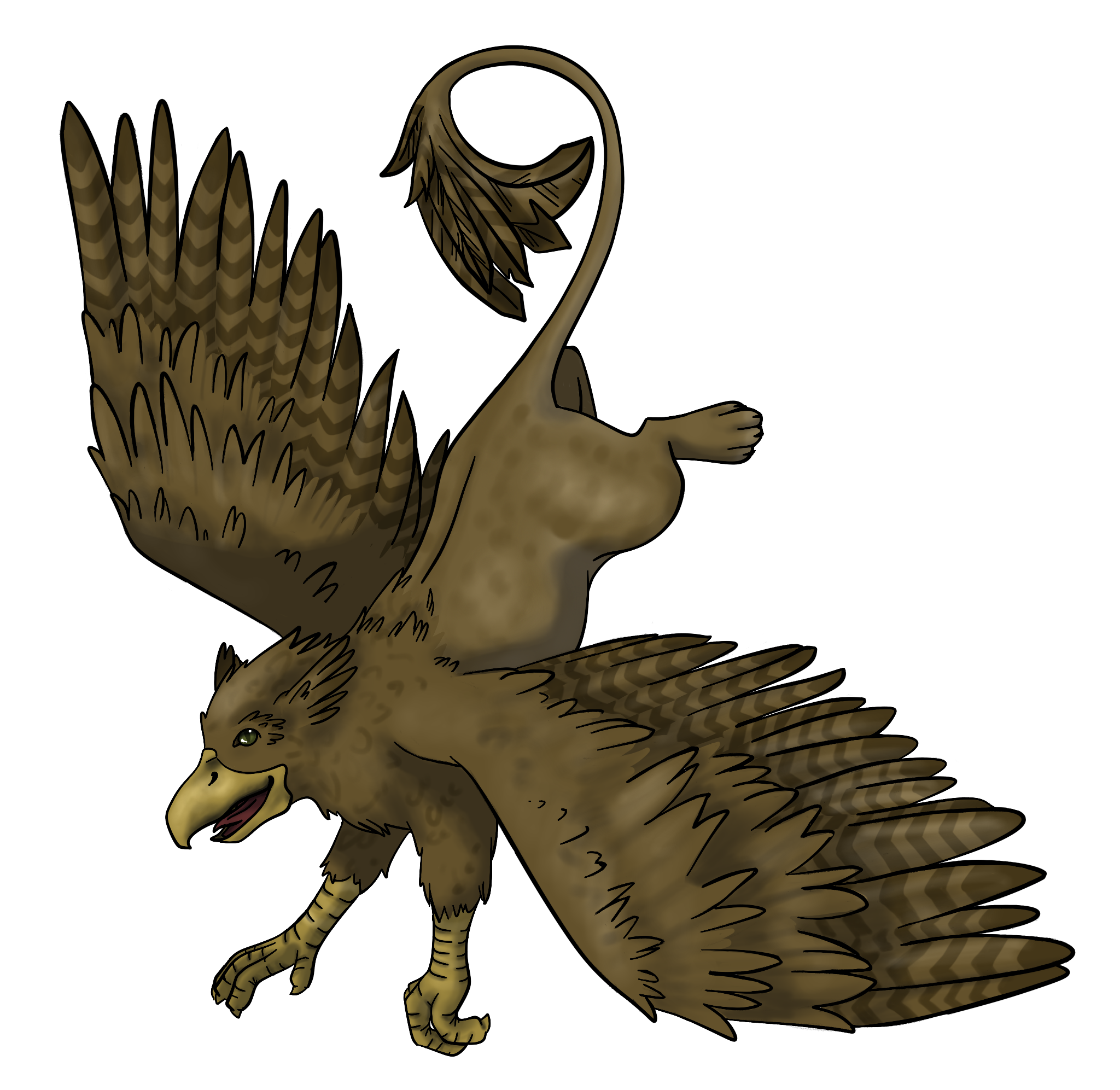Gryphon
Basic Information
Anatomy
Gryphons are the cross between a bird (usually a bird of prey) and a big cat. They always have an avian head and neck, complete with large tufted ears, and big feathered wings. Most have feathers continuing all the way down the forelegs, which typically end in hand-like talons. Their bodies and hind limbs are big cat-like, ending in paws. On rare occasions, they will have four paws instead. They have long, cat-like tails that might end like a cat's does or might end in a feathered tuft.
Genetics and Reproduction
Gryphons typically mate for life. Some choose to have offspring and some do not, and they are able to control their own fertility periods through special diet and exercise choices. They lay 1-3 eggs, 1 being the most common and 2 and 3 increasingly rare. Genetically, offspring are usually a build and coloration combination of both parents but can also strongly resemble one parent or the other, or even have genetics from further up the family tree reappear.
Growth Rate & Stages
Gryphons have fairly well defined stages of growth.
Egg A female gryphon will lay her 1-3 eggs 5-10 days after mating. Eggs take about 12 months to hatch, give or take about a month on either side.
Hatchling Just-hatched gryphons require the full-time care of a parent (and usually get both). They are born blind and deaf; they can usually hear at about a week and see at about 10 days. They have undeveloped wings, soft downy coats, and must learn to sit and stand up on their own during this time. They are considered Hatchlings for about a month.
Nestling At about a month, gryplets are considered nestlings. During their second month, they will begin to shed their down nest feathers and grow a first set of adult feathers, including in their wings. They learn to walk, run, and tumble. This stage lasts another month.
Fledgeling In their third month of life, gryphlets are considered fledglings - so called because they have grown their first full set of feathers on their wings and begin learning to fly. For the remainder of the first year, they retain some downy feathers, especially in sensitive areas and the undersides of the wings, so they are not capable of sustained flight or flight in bad weather. At this point, they also start learning to hunt on their own. They will grow considerably and rapidly during this time, and at various points may have spells of difficult flight when there is a size and feather mismatch. They are still considered fledglings until they they turn two, at which point they have mostly finished growing.
Young Adult A gryphlet is considered a young adult from the time they turn two until somewhere around 25. During this time they still live with their parents or in larger family groups and are learning and honing skills. They may begin looking for a partner, but will not mate or formally take a partner until they are adults.
Ecology and Habitats
Gryphons are native to the continent of Westra, and most commonly found on the plains and in the jungles of the United Tribes of Mare'n, though they still occupy the territories of the Kingdom of Delryn in fewer numbers. They are intelligent enough to adapt to any environment, and some are avid travellers who have settled elsewhere in the world.
Dietary Needs and Habits
Gryphons are carnivores, and due to their size they require a large amount of meat. Most maintain a mammal-heavy diet, but they can eat fish and some prefer it. They are known to hunt solitarily, in pairs, and in groups, and those who frequently consume fish are also talented fishers. As intelligent beings, they understand the need to maintain a healthy food source and are responsible hunters, often intentionally choosing old animals or poor producers, and taking care not to overhunt.
Additional Information
Social Structure
Gryphons tend to live in family units, a mated pair and any offspring they may have that are not fully matured. They may form slightly larger groups called Flights that share a geographical area and share hunting, child-rearing, and protection responsibilities.
Domestication
Gryphons cannot be "domesticated" any more than dragons and unicorns; they are a sentient species all on their own. They can befriend two-legged sentient creatures, and may choose to carry them or work with them or even join their society, but they cannot be domesticated.
Geographic Origin and Distribution
Gryphons are found most commonly on Mare'n tribal lands, but are not an infrequent sight in Delryn. However, gryphons who live near human settlements must either establish some sort of trade with local humanoids for farmed meat or fly further afield to get enough to eat, which can complicate their choices. They are adventurous by nature and have been known to settle worldwide.
Perception and Sensory Capabilities
Gryphons have excellent sight and hearing. They are inherently magical, and some can be magic users.
Civilization and Culture
Major Language Groups and Dialects
Gryphons are capable of telepathy amongst themselves and to others from birth. Those who commonly interact with humanoids can learn to speak aloud, though it takes some effort with the beak.
Lifespan
300-500 Years
Conservation Status
Uncommon, Not Endangered
Average Height
4.5-6 Feet
Average Weight
500-1000 Pounds
Average Length
8-12 Feet
Body Tint, Colouring and Marking
Gryphons come in a variety of natural colors, usually shades of black, brown, and gray that are reminscent of their avian and feline cousins. Often, they have the colors and markings of the birds of prey they most resemble, but all natural colors occur. More rarely, there are subspecies of gryphon that have the avian parts of more exotic birds (such as parrots and hummingbirds) that are more colorful.



Comments